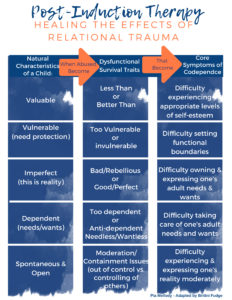I am humbled and honored to offer Pia Mellody’s Post Induction Therapy (otherwise known as PIT) to my clients. Combined with EMDR, this model has been the most helpful and healing model of therapy for my clients.
Once I started using this model, clients were saying things like:
- “You just verbalized what I’ve been trying to figure out for years.”
- “I’ve seen 4 other therapists but you’re the first one who figured out what was causing my anxiety and depression.”
- “I started coming to counseling to get help with parenting, but I’m learning so much more about myself and healing deeper issues … it has made such a difference.”
- “You’ve been able to point out things going on in my life that I’m too close to notice.”
- “Counseling has been even more helpful than I originally expected. I’m glad it’s morphed into a more in-depth look into places and things about me that have been difficult for me to work on alone.”
So What is Post-Induction Therapy?
Pia Mellody’s model consists of therapeutic techniques that identify and treat the underlying pain and trauma of most addictive and dysfunctional processes.
Often, issues such as:
- depression
- anxiety
- perfectionism
- eating disorders
- parenting difficulties
- relationship problems
- addiction
- numbing out behaviors
all have roots in the messages—both direct messages and indirect messages—that we received as children. Adults are making choices and decisions daily that are informed by how we were raised, which informs our values, fears, and priorities. Once we can identify and heal these non-adaptive messages, we can make decisions and choices that better align with our true selves.
The PIT model explores and heals one’s childhood trauma.
The term “Childhood Trauma” can sound a little big and scary, but it includes:
- Relational Trauma (this can include chaotic/hostile relationships, demeaning messages from caregivers, etc.)
- Adverse Childhood Experiences
- Abuse (which can be thought of as anything less-than-nurturing)
- Neglect
The important thing to note is that very few parents are intentionally trying to harm their children. Inadvertently, parents sometimes don’t honor the natural characteristics of a child.
All children have 5 Natural Characteristics:
- Precious (they are human)
- Vulnerable (they need protection)
- Imperfect (they are perfectly imperfect human beings)
- Dependent (they need help)
- Spontaneous and Open (immature)
When parents and caregivers are able to honor and nurture these characteristics most of the time, the child develops in a healthy way, knowing his/her own worth. When this child grows into an adult, the adult is able to behave as a functional adult who knows how to set limits, esteem themselves, set functional boundaries, express and tend to needs and wants, and live in moderation.
When these characteristics of a child aren’t honored and handled with care, over time, the child’s psychological/emotional growth and development can become stunted, which results in what Pia Mellody terms as developmental immaturity.
This can be shown below:

What does Recovery & Growth Look Like?
The PIT model is psychoeducational at its core (meaning, the client learns a great deal about the 5 core symptoms show above and how they show up in their life). In addition, the PIT model helps clients get rid of difficult emotions that are leftover from painful childhood experiences while teaching the client how to re-parent the self as a functional adult who knows how to nurture and affirm themselves, set limits, and live in balance.
While recovery does involve exploring the less-than-nurturing aspects of our childhoods, the focus is on the IMPACT of these experiences, not on INTENT. In other words, this model is not centered on blaming your parents/caregivers, but on naming and healing the less-than-nurturing aspects of your childhood.
Because this model gets at the root of the problem that brought you into counseling, this model can be thought of as a cure, rather than a bandaid, of what brings us into counseling. While this model is not considered brief therapy, it is the most comprehensive and effective method of counseling I’ve used with clients.
If you’re interested in getting to the root of your problems and healing, reach out to me so we can see if this model would be a good fit for you.

